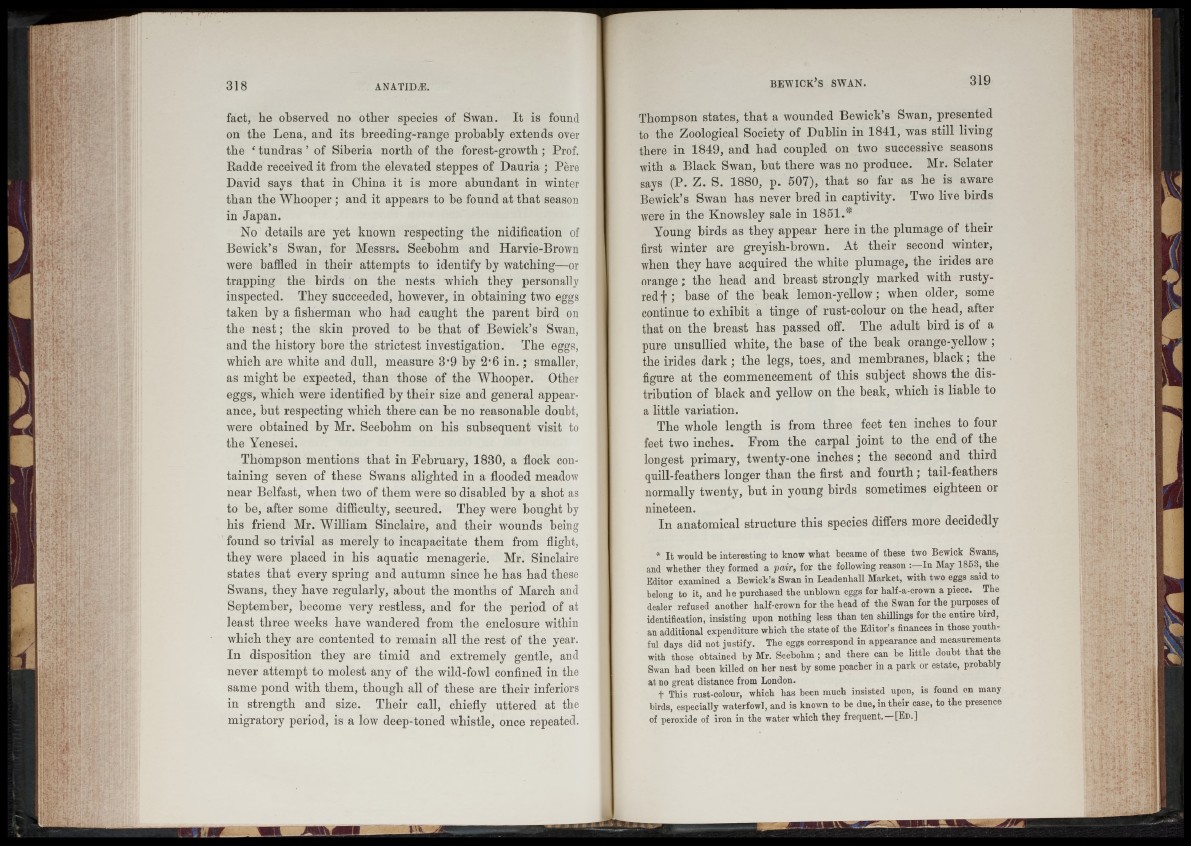
fact, lie observed no other species of Swan. It is found
on the Lena, and its breeding-range probably extends over
the ‘ tundras ’ of Siberia north of the forest-growth ; Prof.
Radde received it from the elevated steppes of Dauria ; Père
David says that in China it is more abundant in winter
than the Whooper ; and it appears to be found at that season
in Japan.
No details are yet known respecting the nidification of
Bewick’s Swan, for Messrs. Seebohm and Harvie-Brown
were baffled in their attempts to identify by watching—or
trapping the birds on the nests which they personally
inspected. They succeeded, however, in obtaining two eggs
taken by a fisherman who had caught the parent bird on
the nest ; the skin proved to be that of Bewick’s Swan,
and the history bore the strictest investigation. The eggs,
which are white and dull, measure 3'9 by 2’6 in. ; smaller,
as might be expected, than those of the Whooper. Other
eggs, which were identified by their size and general appearance,
but respecting which there can be no reasonable doubt,
were obtained by Mr. Seebohm on his subsequent visit to
the Yenesei.
Thompson mentions that in February, 1830, a flock containing
seven of these SwTans alighted in a flooded meadow
near Belfast, when two of them were so disabled by a shot as
to be, after some difficulty, secured. They were bought by
his friend Mr. William Sinclaire, and their wTounds being
found so trivial as merely to incapacitate them from flight,
they were placed in his aquatic menagerie. Mr. Sinclaire
states that every spring and autumn since he has had these
Swans, they have regularly, about the months of March and
September, become very restless, and for the period of at
least three weeks have wandered from the enclosure within
which they are contented to remain all the rest of the year.
In disposition they are timid and extremely gentle, and
never attempt to molest any of the wild-fowl confined in the
same pond with them, though all of these are their inferiors
in strength and size. Their call, chiefly uttered at the
migratory period, is a low deep-toned whistle, once repeated.
Thompson states, that a wounded Bewick’s Swan, presented
to the Zoological Society of Dublin in 1841, was still living
there in 1849, and had coupled on two successive seasons
with a Black Swan, but there was no produce. Mr. Sclater
says (P. Z. S. 1880, p. 507), that so far as he is aware
Bewick’s Swan has never bred in captivity. Two live birds
were in the Knowsley sale in 1851.*
Young birds as they appear here in the plumage of their
first winter are greyish-brown. At their second winter,
when they have acquired the white plumage, the irides are
orange ; the head and breast strongly marked with rusty-
red f ; base of the beak lemon-yellow; when older, some
continue to exhibit a tinge of rust-colour on the head, after
that on the breast has passed off. The adult bird is of a
pure unsullied white, the base of the beak orange-yellow ;
the irides dark ; the legs, toes, and membranes, black; the
figure at the commencement of this subject shows the distribution
of black and yellow on the beak, which is liable to
a little variation.
The whole length is from three feet ten inches to four
feet two inches. From the carpal joint to the end of the
longest primary, twenty-one inches; the second and third
quill-feathers longer than the first and fourth; tail-feathers
normally twenty, but in young birds sometimes eighteen or
nineteen.
In anatomical structure this species differs more decidedly
* It would be interesting to know what became of these two Bewick Swans,
and whether they formed a pair, for the following reason :-—In May 1853, the
Editor examined a Bewick’s Swan in Leadenhall Market, with two eggs said to
belong to it, and he purchased the unblown eggs for half-a-crown a piece. The
dealer refused another half-crown for the head of the Swan for the purposes of
identification, insisting upon nothing less than ten shillings for the entire bird,
an additional expenditure which the state of the Editor’s finances in those youthful
days did not justify. The eggs correspond in appearance and measurements
with those obtained by Mr. Seebohm ; and there can be little doubt that the
Swan had been killed on her nest by some poacher in a park or estate, probably
at no great distance from London.
t This rust-colour, which has been much insisted upon, is found on many
birds, especially waterfowl, and is known to be due, in their case, to the presence
of peroxide of iron in the water which they frequent. [Ed.]